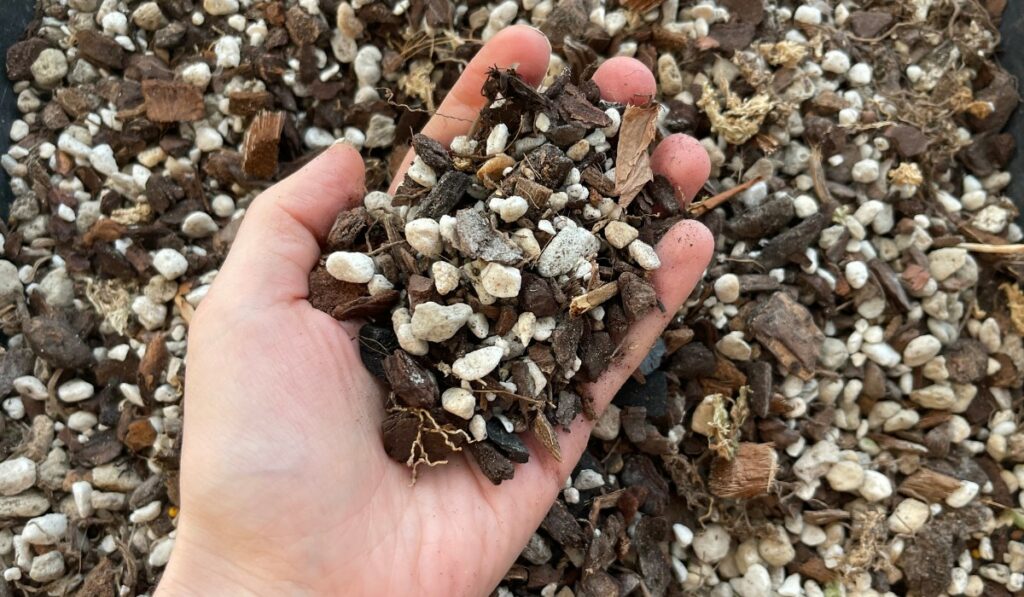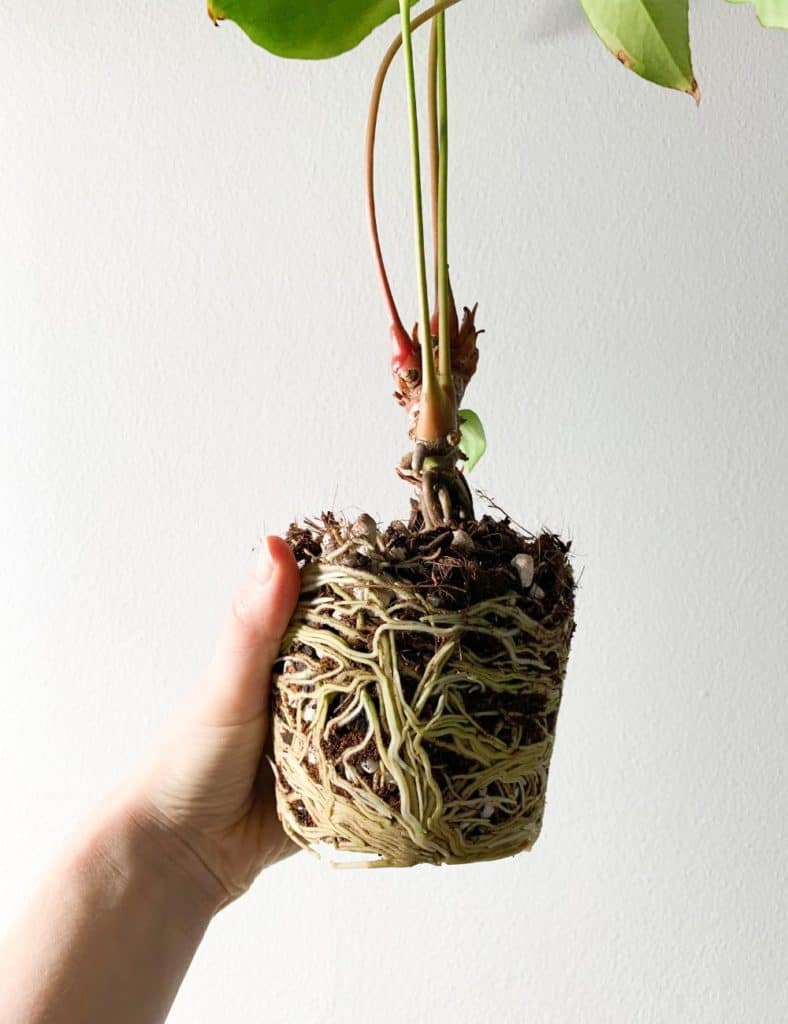The best potting soil for anthurium plants is a well-draining, chunky mix of organic and inorganic nutrient-rich substrates. A good potting mix for anthuriums is a mix of pine/fir bark, perlite, coconut fibers, coco peat or peat moss, and horticultural charcoal. Anthurium plants prefer slightly acidic soil, and ideal soil acidity is between 5.5 to 6.5 pH.
I’ll guide you through anthurium soil requirements, my favorite potting mix recipe you can steal, and a primer on different potting mix ingredients you can mix and match to arrive at your own ideal potting mix. Of course, you can also buy ready-made potting mix for aroids, but where’s the fun in that?

The best potting soil for anthuriums: No soil mix
Yes, you’ve read it correctly. Anthurium growers and enthusiasts alike do not use regular garden soil in their own potting mix for anthuriums because it is simply too dense and too moisture retentive. This can lead to root rot.
Instead, a well-draining and loose mix that mimics their natural tropical forest floor habitat is preferred.
Anthurium Potting Mix Recipe
I used the following potting mix ingredients in the past to experiment with which potting mix recipe the anthuriums will grow the fastest and the best.
The ideal potting soil is a well-draining potting mix that provides adequate drainage, prevents dense soil, and creates a kind of fluffy growing medium.
If you have wondered how to make your own potting soil, you’re in the right place. It’s very easy. You need only a few ingredients. Steal my recipe and grow a thriving Anthurium jungle.
- 2 parts pine bark
- 1 part perlite
- 1 part coco coir
- 1/8 part of worm castings
- 1/8 part of horticultural charcoal
- optional: vermiculite or pumice
Pro Tip: Add some leca balls at the bottom of your container to prevent waterlogging of your potting mix. If you don’t have leca, put some larger bark pieces at the bottom. This ensures that the smaller ingredients don’t block your drainage holes.
Mix all ingredients well; pot your anthurium and water thoroughly to set the potting mix.
Read Next: Water Like a Pro: An Essential Guide to Anthurium Watering
Read Next: The Ultimate Guide to Repotting Anthuriums: When & How to Repot
Most frequently used anthurium potting mix ingredients
Let’s dive into the most commonly used anthurium potting mix ingredients.
I used the following potting mix ingredients in the past to grow various anthurium plants. Mix and match them to arrive at your ideal potting mix recipe. Part of the fun when growing anthuriums is experimenting with different soil mediums and seeing which works best for you.
Pine bark or Fir bark
Pine bark is the outermost protective layer of pine trees. It’s processed into smaller pieces or shreds and used in potting mixes to improve soil structure, promote drainage, and slowly release nutrients as it decomposes.
Both pine and fir bark contribute to a well-draining soil mix and provide anthuriums something to attach the roots to. Many anthuriums are epiphytes that grow on trees and love their roots to be attached to the bark.
I use Orchiata Pine bark (orchid potting mix) in various sizes. For Anthuriums with chunkier roots like Anthurium pedatum, I use larger size bark pieces (9-12mm), and for finer root Anthuriums such as Anthurium warocqueanum, I use smaller pieces (6-9mm).
Peat Moss
Peat moss is a decomposed, fibrous material sourced from peat bogs, formed through the slow decay of mosses and other organic materials in damp, boggy environments. It’s often used in Anthurium potting mixes because it is very moisture retentive.
Additionally, peat moss’s slightly acidic pH helps create a soil environment that aligns with Anthurium’s nutrient needs. In my early days of growing anthuriums, I used peat moss in my potting mix, but I stopped for two reasons.
1) It quickly accumulates at the bottom of the pot, pushing lighter ingredients such as perlite to the top. Consequently, it creates a very dense substrate at the bottom and prevents even moisture throughout the pot. It clogs the bottom and contributes to root rot.
2) It is environmentally unsustainable. Peat bogs are unique ecosystems created over hundreds of years. Harvesting peat moss destroys the unique ecosystem. Sustainable alternatives include coco coir & coco husk.
Perlite
Perlite is a form of volcanic glass that is heated and expanded to create lightweight, porous particles. Perlite is vital in enhancing drainage and aeration in an Anthurium potting mix.
It prevents waterlogging and root rot by improving water flow through the soil. Simultaneously, its porous nature increases the oxygen level around the roots, promoting healthier growth and development of the Anthurium plants.
Coco peat
Coco peat, also known as coir or coconut fiber, is a natural byproduct derived from coconut husks. In an Anthurium potting mix, coco peat acts as a soil conditioner, improving the soil’s capacity to retain water while promoting good drainage and aeration.
Its fibrous nature creates a loose, airy soil structure, fostering healthy root development. As a bonus, coco peat is also slightly acidic, aligning well with Anthuriums’ pH preference, thus contributing to their optimal growth.
Pumice
Pumice is a type of volcanic rock that is light, porous, and abrasive. Pumice is vital in promoting proper drainage and aeration in an Anthurium potting mix. Its lightweight and porous nature prevents waterlogging by enhancing water flow through the soil and increasing the oxygen level around the roots.
Horticultural charcoal
Horticultural charcoal, often made from burned hardwood, is used in gardening for its excellent absorptive properties. In an Anthurium potting mix, horticultural charcoal helps to improve drainage and maintain a clean and healthy medium by absorbing excess moisture, impurities, and odors. It prevents fungal infection and stops nutrient leaching from the soil.
Vermiculite
Vermiculite is a naturally occurring mineral that expands when heated, resulting in a lightweight, absorbent material. In an Anthurium potting mix, vermiculite serves a dual purpose: enhancing soil aeration and improving moisture retention.
Its light, airy nature helps prevent soil compaction, promoting better root growth. Simultaneously, its excellent water-holding capacity ensures that Anthurium plants have a consistent moisture supply. However, it’s essential to balance vermiculite with other ingredients to prevent overwatering, as its high water retention could potentially lead to root rot.
Tree Fern Fiber
Tree fern is a type of fibrous material derived from certain species of tree ferns. In an Anthurium potting mix, tree fern fibers enhance the mix’s aeration and drainage. These fibers create a loosely packed, porous medium that allows air and water to circulate freely around the Anthurium roots, preventing root rot and promoting healthier growth.
Additionally, tree fern fibers can retain moisture while providing good drainage, ensuring a constant but not excessive water supply for the plant. Often used for rooting Anthurium plants during propagation, tree fern functions in a manner akin to sphagnum moss.
Worm Castings
Worm castings, also known as vermicompost, are a type of organic fertilizer produced by earthworms digesting plant material. In an Anthurium potting mix, worm castings are a nutrient-rich supplement. They enrich the soil with essential minerals and beneficial microbes, promoting healthier plant growth. The castings improve the soil’s structure, enhancing its ability to retain water and nutrients. Worm castings are also known to enhance the soil’s resistance to pests and diseases.
Additional anthurium potting mix ingredients for advanced growers
Fertilizers
Anthuriums thrive best with balanced fertilizers that contain equal parts nitrogen, phosphorus, and potassium, often labeled as 20-20-20 or similar. Nitrogen supports leaf growth, phosphorus aids root and flower development, and potassium enhances overall plant health.
Additionally, Anthuriums benefit from fertilizers with trace elements like iron, magnesium, and calcium. These plants prefer water-soluble fertilizers applied at half-strength, as they are sensitive to over-fertilization. The best practice is fertilizing lightly but frequently to support their continuous growth. I use water-based fertilizers in addition to worm castings already in the potting mix.
Sphagnum moss
Sphagnum moss encourages rooting, and I frequently use it to top dress potting mix. It promotes the stem to grow additional roots. More roots mean a healthier plant that grows faster. After all, we want those incredible leaves to pop out more frequently, and sphagnum moss plays an essential role. Sphagnum moss is particularly useful for propagating Anthuriums.
Inoculants
Inoculants, in a horticultural context, are typically beneficial microbes or fungi introduced to the soil to promote plant growth. In Anthurium growth, inoculants often include mycorrhizal fungi or beneficial bacteria. These microbes establish a symbiotic relationship with the plant, enhancing nutrient uptake and improving plant health.
Mycorrhizal fungi, for example, extend their network into the soil, increasing the root’s surface area for nutrient absorption. These inoculants also aid in plant stress tolerance, enhancing Anthurium’s resilience against environmental changes, pests, and disease. The result is a healthier, more robust Anthurium plant.

Frequently asked questions about anthurium soil:
Can you grow anthurium in regular soil?
I wouldn’t recommend it. Regular potting mix is very dense and would promote standing water, something anthurium plants hate. Anthuriums like their roots to be moist but not constantly wet.
What are common signs of using incorrect potting soil?
One of the most common signs of bad potting mix is yellowing leaves caused by too water retentive mix. Poorly draining soil mix can also cause root rot which is challenging to come back from.
What pH levels in the soil are best for Anthuriums?
Anthurium plants prefer slightly acidic soil, and ideal soil acidity is between 5.5 to 6.5 pH.
How often should you repot your anthurium?
I have an in-depth guide on repotting anthuriums. Check it out!
Related articles:

